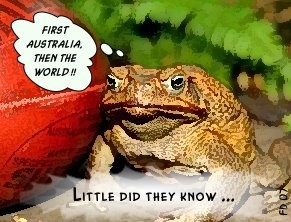
Monsanto attempted to suppress test study data which when independently evaluated by a French team from the University of Caen after Greenpeace was successful in obtaining a court order to release the data, showed rats fed the GE corn experienced higher levels of liver and kidney toxicity.
The same data was available to the national regulator, Food Standards Australia New Zealand (FSANZ), in 2004 yet FSANZ failed to assess it, relying solely on Monsanto’s analyses which, according to Professor Seralini, “do not stand up to rigorous scrutiny”.
…
The study results were published last week in the journal Archives of Environmental Contamination and Toxicology. The study was headed by Professor Gilles Eric Seralini, a French government scientist and expert in GE technology from the University of Caen. His team of experts analysed the results of safety tests submitted by the world’s largest genetic engineering company, Monsanto. The study found that “with the present data, it cannot be concluded that GM corn MON863 is a safe product”.
Food Standards Australia New Zealand (FSANZ) based its assessment of the GE corn on Monsanto’s advices, declaring it safe for humans.
FSANZ had access to the test data (on which the new study was based) back in 2004 and still gave this toxic corn the okay.
An historical chronology of Monsanto’s deception and subsequent revelations can be downloaded here with an indepth fact sheet here.






More damaging effects of GM crops are detailed by the results of this scientific study:
The dangers of cross-fertilisation by GM crops are highlighted by these scientific findings, which again give the lie to Jones’ blanket claim that “No damaging effects have been documented for GM crops or GM food.”
Another of Jones’ arguments, that “Thanks to GM cotton, thousands of tons of insecticide have not been sprayed in fields, and fewer farm workers are poisoned by insecticides”, is demolished by these findings:
Jones with his sweeping, carefree “no unknown unknowns” displays an arrogant and unscientific attitude.
The cane toad is laughing at him.
It is also worth considering the reservations of the UCS in regard to contamination of traditional crops with GM genetic material.
We need to be careful about trusting big business – their aim is to make money, not to take responsibility for the disastrous side effects of their primary aim unless forced to do so (think James Hardie for a good recent local example). Monsanto has been previously sprung for nefarious activities.
If there is no problem with its products, why is Monsanto so keen to resist studies of their environmental impact that it is prepared to break the law?
Also, see Patrick Chalmers’ comment on The Seeds of Suicide, a film which exposes the human costs to farmers of GM crops.
Along with the findings of Seralini, Pusztai and Haefeker, the above film exposes Jone’s statement that “no damaging effects have been documented for GM crops or GM food” as deceptive.
Then it is worthwhile to absorb the conclusions of the Defra Research Report 17: The Risks and Consequences of Gene Transfer from Genetically-Manipulated micro-organisms in the Environment.
We need more information and research before we can be confident that GM crops do not create unintended catastrophic consequences just as the introduction of the cane toad has. Given their past perfidious behaviour, we certainly can’t trust corporations like Monsanto to act for the good of anything else other than their own profits.
The Guardian describes Jonathan D G Jones: “Jonathan Jones is a leading plant geneticist and authority on plant disease resistance. He is head of the charitably-funded Sainsbury Laboratory at the John Innes Centre in Norwich.”
Jones in the Guardian: “I have been making transgenic plants for over 20 years. It is the most benign, ecologically sound new method for crop improvement in a century. The more I do it, the less I worry about it. Provided simple and obvious regulatory precautions are taken, there are no plausible scenarios for the technology to cause serious damage. There are some known unknowns that can be tested in any new GM variety, but there are no unknown unknowns.”
“No damaging effects have been documented for GM crops or GM food.”
http://commentisfree.guardian.co.uk/jonathan_dg_jones/2007/03/jonathan_jones_scientist.html
Monsanto is up to more courtroom tricks, attempting to force the use of its GM alfalfa prior to the results of environmental studies.
Is the current catastrophic bee colony die off related to GM modified crops?
Unlike Preston and you, the European Commission is taking Seralini’s study seriously.
It appears Preston is challenging just two of Seralini’s criticisms of Monsanto’s study. From the link to Preston’s critique you quoted:
33 differences is 25% higher than 25, hardly an insignificant variation.
We do not have the benefit of access to Seralini’s full study but see from the abstract of his independent assessment of the Monsanto data provided here:
Seralini’s main and serious criticisms of Monsanto’s study are of its statistical and research methodology.
Furthermore:
Seralini said
We also know that previous studies by German researcher Arpad Pusztai found:
In regard to Preston’s dose response allegation:
Puztai also questioned Monsanto’s research methodology:
Dr. Pusztai’s list of reasons why the Mon 863 study should have been rejected are here.
Also of interest:
Also note that
Finally, Preston appears to wish to denigrate Seralini’s study on the that it was funded by Greenpeace (and, incidentally, Carrefour), however CRIIGEN itself is funded by many organisations. He does not extend his suspicions on this basis to Monsanto’s study, which was of course, funded by Monsanto.
Preston is self-admittedly not a GM researcher. It seems to me that if there is *any* legitimate doubt about toxicity of particular GM products – particularly that expressed in peer reviewed scientific journals – then further studies with sound methodology and statistical evaluation are warranted before these products are unleashed. Research of large multinational companies with obvious vested interests can not be trusted without independent review.
The corn toxicity story is bogus.
See: http://gmopundit.blogspot.com/2007/03/lies-damn-lies-and-statistics.html